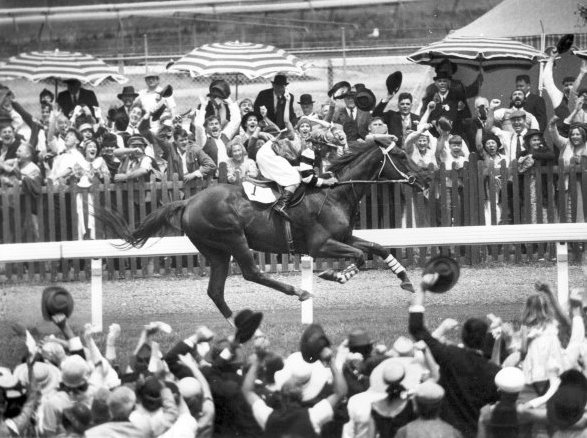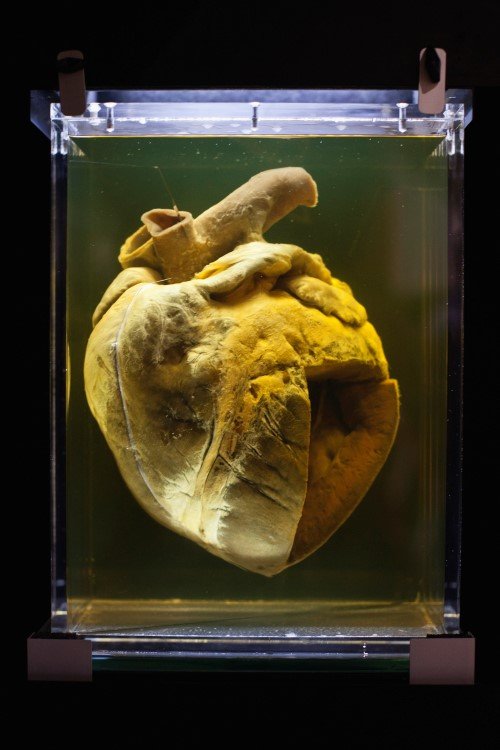On this day: Phar Lap’s death shocks the racing world

On the morning of Tuesday, 5 April 1932, Phar Lap, the racehorse legend, mysteriously collapsed at a farm outside San Francisco 16 days after he won the Agua Caliente handicap in Tijuana, Mexico. He died in the arms of Tommy Woodcock, his dedicated strapper and mate.
As the news of the horse’s death filtered through the press the next morning, the nation mourned in disbelief. And even now, 85 years after his death, the memory of that day still lingers.
Phar Lap is an Australian hero not only due to his unparalleled speed on the racetrack, but also because he captured the public’s imagination during one of the most difficult economic periods in Australia.
“Phar Lap is unique not so much for what he achieved, but for the way the nation saw his achievements as uniquely Australian,” says Dr Mark O’Neill, a sports historian, who completed his PhD on Phar Lap at the University of Queensland.
The horse’s unprecedented success during a vulnerable time – The Great Depression – fostered Australian patriotism and strength, and his legacy continues to live on in the Australian cultural narrative.

Phar Lap stands with his strapper and mate, Tommy Woodcock, before his trip to the United States. (Image: Charles P S Boyer/National Library of New Zealand)
Phar Lap’s achievements
The 1930s champion thoroughbred, standing at 1.74m tall with a deep chestnut coat, often carried a significant weight handicap and came from humble origins. Born in New Zealand in 1926, Phar Lap was an underdog cheaply leased by an unknown trainer, Harry Telford, and he did not appear to have any racing talent.
Despite these disadvantages, Phar Lap surprised the nation and dominated the Australian racing industry. He won 37 races from 51 starts, usually winning by several lengths and racing at a spectacular half-paced speed.
“He was a biological freak,” says Mark. “The horse had amazing endurance, and did some amazing things under stress.”
One of Phar Lap’s biggest accomplishments was his performance during the 1930 Melbourne Cup, carrying a 62kg handicap for his age group. He was the only horse in Australian history to have been favourite for the Melbourne Cup three years in a row.
During the 1930 Melbourne Spring Carnival, Phar Lap won four races in seven days – and this was after he survived an assassination attempt, a gunshot fired from a nearby motor car.
“He survived an assassination attempt on Saturday morning, won an event that Saturday, went into hiding, won the Melbourne Cup on Tuesday, won another event on Thursday, and won another event on Saturday,” says Mark, adding “That will never, ever happen again.”
Phar Lap’s last race
Unsurprisingly, Phar Lap won his last race in Mexico with flying colours.
The entire nation watched in awe as Phar Lap went from second-to-last to first on the track. “The horse was able to do something quite spectacular by giving up so much head start at the beginning, and then being able to run down the horses in the lead,” Mark says.
His remarkable performance in Agua Caliente made it even harder for Australians to accept his death just 16 days later.
“The illness of Phar Lap was kept secret”
After the race, Phar Lap was taken back up to San Francisco with strapper Tommy Woodcock where he would spend the last few days of his life.
“Phar Lap dead: collapse in California.” The stinging reality of Melbourne’s The Argus newspaper headline on 7 April struck the nation, and the racehorse’s death was the leading news story in Australia for several days.
“Phar Lap, the champion Australian racehorse, was stricken this morning by symptoms of colic, which developed so rapidly that veterinary surgeons were unable to counteract the illness,” The Argus reported. “The illness of Phar Lap was kept a secret by the stable.”
The uncertainty surrounding the death riled the country. Conspiracy theories that the horse was sabotaged soon spread among the press and the public, while rumours surfaced that Phar Lap was poisoned by American gangsters who were threatened by his winning streak.
In 2011, new evidence came to light confirming Phar Lap died as a result of arsenic ingestion. Unfortunately, how or why Phar Lap consumed the arsenic remains unknown.
We may never know who is to blame for Phar Lap’s death, but that immediate instinct to blame America is significant, says Mark, as it reflects an overall deflation of national pride.
“Phar Lap was considered a symbol of national achievement. And by winning in the United States and proving an Australian can conquer the biggest and the most powerful nation in the world, Australians took a lot of confidence out of that,” he says. “And for Phar Lap to die, meant that a lot of Australia’s confidence through that horse dissipated.”
Over eight decades later, Australians still feel angered and betrayed by the ambiguity surrounding their beloved racehorse’s downfall.
The death of Phar Lap was not just the death of a horse – it was also, in many ways, a loss of cultural identity.

Phar Lap’s heart, weighing 6.35kg, is on display at the National Museum of Australia. The phrase “a heart as big as Phar Lap’s” signifies strength, power, and generosity. (Image: National Museum of Australia)
Big Red and his big heart
Phar Lap’s large heart carries its own legacy. After his death, thoroughbred experts examined the horse’s heart to find it was 1.5 times bigger than average, weighing 6.35kg.
Some studies have shown that Phar Lap’s heart size explained his superior racing powers. However, the importance of his heart is more than just a physical contribution to Phar Lap’s success – it is part of Phar Lap’s inspiring story. Australians coined the saying “a heart as big as Phar Lap’s” to celebrate the horse’s incredible resilience.
“Phar Lap is seen as a representation of everything that’s great about Australian culture,” says Mark. “What we celebrate about Phar Lap is what we try to celebrate about ourselves. This is why his death remains so poignant.”
The horse’s sincere mateship with strapper Tommy Woodcock, his rise from humble origins, and his triumph against America spoke powerfully in accordance with the voices of the Australian people.
Phar Lap’s legacy will endure as an unforgettable part of Australia’s cultural narrative.

